maintenance OLDSMOBILE SILHOUETTE 1996 Owners Manual
[x] Cancel search | Manufacturer: OLDSMOBILE, Model Year: 1996, Model line: SILHOUETTE, Model: OLDSMOBILE SILHOUETTE 1996Pages: 372, PDF Size: 19.39 MB
Page 3 of 372
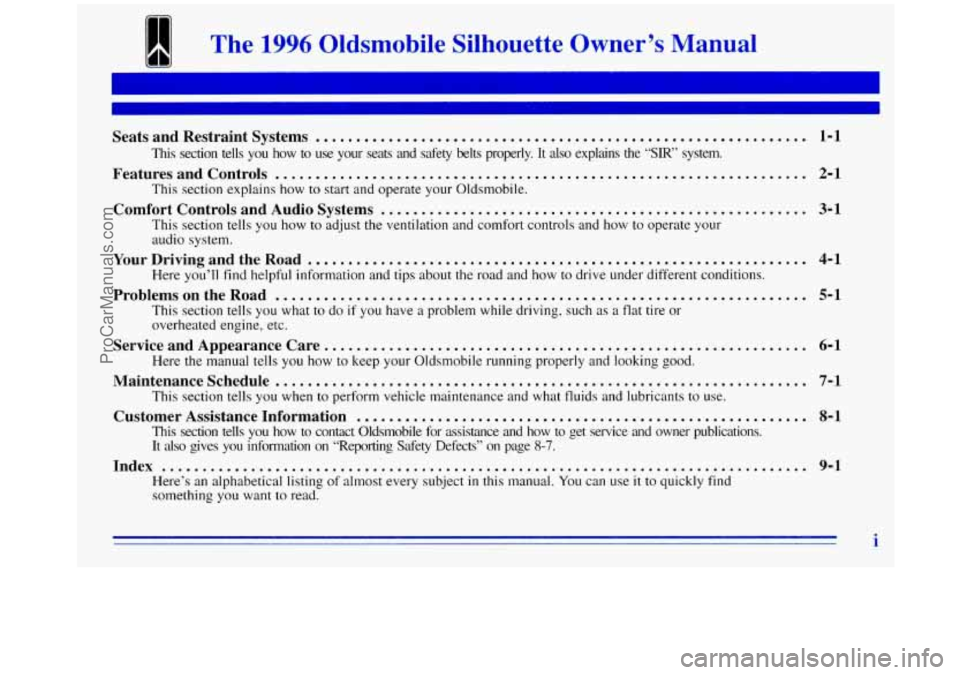
The 1996 Oldsrnobile Silhouette Owner’s Manual
Seats and Restraint Systems ............................................................. 1-1
Features and Controls .................................................................. 2-1
Comfort Controls and Audio Systems ..................................................... 3-1
This section tells you how to use your seats and safety belts properly. It also explains the “SIR” system.
This section explains how to start and operate your Oldsmobile.
This section tells you how to adjust the ventilation and comfort controls and how to operate your
audio system.
YourDrivingandtheRoad .............................................................. 4-1
Here you’ll find helpful information and tips about the road and how to drive under different conditions.
ProblemsontheRoad .................................................................. 5-1
This section tells you what to do if you have a problem while driving, such as a flat tire or
overheated engine, etc.
Here the manual tells you how to keep your Oldsmobile running properly and looking good.
This section tells you when to perform vehicle maintenance and what fluids and lubricants to use.
This section tells you how to contact Oldsmobile for assistance\
and how to
get service and owner publications.
It also gives you information on “Reporting Safety Defects”\
on page
8-7.
Here’s an alphabetical listing of almost every subject in this manual. You can use it to quickly find
something you want to read.
ServiceandAppearanceCare ............................................................ 6-1
Maintenanceschedule............ ...................................................... 7-1
Customer Assistance Information ........................................................ 8-1
Index ........................................................................\
........ 9-1
i
ProCarManuals.com
Page 38 of 372

Safety Belt Use During Pregnancy Servicing Your Air Bag-Equipped Oldsmobile
The air bag affects how your Oldsmobile should be
Safety belts work for everyone, including pregnant
serviced. There
are Parts of the air bag system in several
women. Like all occupants, they are more likely to be
places around your vehicle. You don’t want the system
seriously injured if they don’t wear safety belts.
I to inflate while someone is working on your vehicle.
I Your Oldsmoblle retailer and the Silhouette Service
1 Manual have information about servicing your vehicle
1 and the air bag system. To purchase a service manual,
see “Service and Owner Publications” in the Index.
For up to two minutes after the ignition key is
turned off and the battery is disconnected, an air
bag can still inflate during improper service. You
can be injured
if you are close to an air bag when
it inflates. Avoid wires wrapped with yellow tape,
or yellow connectors. They are probably part
of
the air bag system. Be sure to follow proper
service procedures, and make sure the person
performing work for you
is qualified to do so.
The air bag system does not need regular maintenance.
A pregnant woman should wear a lap-shoulder belt, and
the lap portion should be
worn as low as possible, below
the rounding, throughout the pregnancy.
1-30 ~
ProCarManuals.com
Page 64 of 372
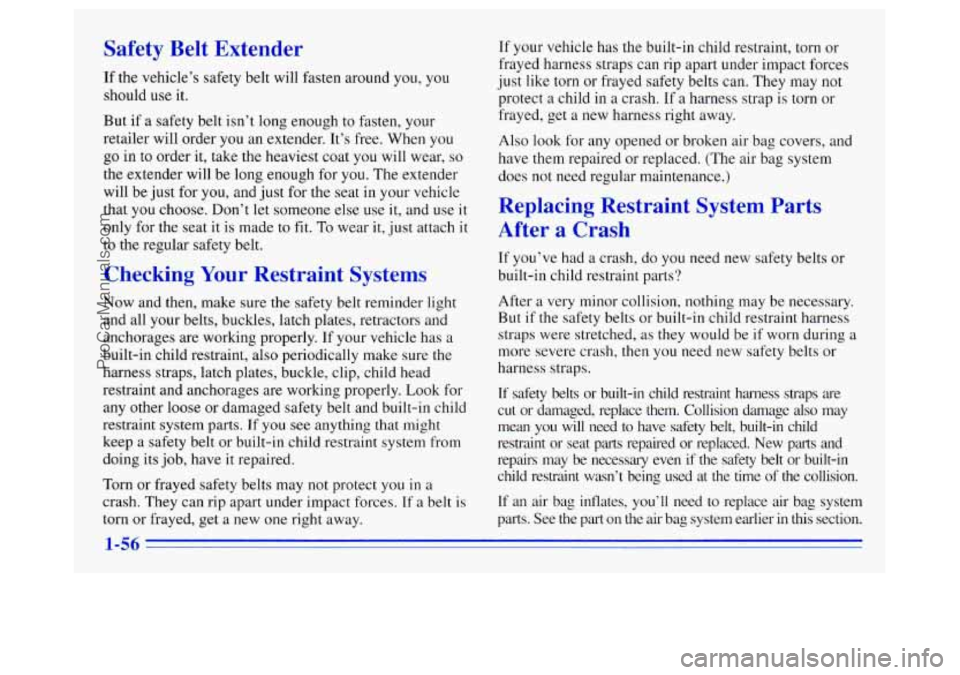
Safety Belt Extender
If the vehicle’s safety belt will fasten around you, you
should use it.
But if a safety belt isn’t long enough to fasten, your
retailer will order
you an extender. It’s free. When you
go in to order it, take the heaviest coat you will wear,
so
the extender will be long enough for you. The extender
will be just for you, and just for the seat
in your vehicle
that you choose. Don’t
let someone else use it, and use it
only for the seat it is made to fit. To wear it, just attach it
to the regular safety belt.
Checking Your Restraint Systems
Now and then, make sure the safety belt reminder light
and all your belts, buckles, latch plates, retractors and
anchorages are working properly. If your vehicle has
a
built-in child restraint, also periodically make sure the
harness straps, latch plates, buckle, clip, child head
restraint and anchorages are working properly. Look for
any other loose or damaged safety belt and built-in child
restraint system parts.
If you see anything that might
keep a safety belt or built-in child restraint system from
doing its job, have
it repaired.
Torn
or frayed safety belts may not protect you in a
crash. They can rip apart under impact forces. If
a belt is
torn or frayed, get
a new one right away. If
your vehicle has the built-in child restraint, torn or
frayed harness straps can
rip apart under impact forces
just like torn or frayed safety belts can. They may not
protect a child in a crash. If
a harness strap is torn or
frayed, get
a new harness right away.
Also look for any opened or broken air bag covers, and
have them repaired or replaced. (The air bag system
does not need regular maintenance.)
Replacing Restraint System Parts
After
a Crash
If you’ve had a crash, do you need new safety belts or
built-in child restraint parts?
After a very minor collision, nothing may be necessary.
But if the safety belts or built-in child restraint harness
straps were stretched, as they would be if worn during a
more severe crash, then you need new safety belts or
harness straps.
If safety belts or built-in child restraint harness straps are \
cut or damaged, replace them. Collision damage also may
mean you will need
to have safety belt, built-in child
restraint or seat parts repaired or replaced. New
parts and
repairs may be necesscary even if the safety belt or built-in \
child restraint wasn’t being used at the time of the collis\
ion.
If an air bag inflates, you’ll need to replace air bag system
parts. See the part on the air bag system earlier in
this section.
1-56
ProCarManuals.com
Page 211 of 372

When You Are Ready to Leave After
Parking on a Hill
1. Apply your regular brakes and hold the pedal down
while you:
Start your engine;
0 Shift into a gear; and
Release the parking brake.
2. Let up on the brake pedal.
3. Drive slowly until the trailer is clear of the chocks.
4. Stop and have someone pick up and store the chocks.
Maintenance When Trailer Towing
Your vehicle will need service more often when you’re
pulling
a trailer. See the Maintenance Schedule for more
on this. Things that are especially important
in trailer
operation are automatic transaxle fluid (don’t overfill),
engine oil, belts, cooling system and brake adjustment.
Each
of these is covered in this manual, and the Index
will help you find them quickly.
If you’re trailering, it’s
a good idea to review these sections before you start
your trip.
Check periodically to see that all hitch nuts and bolts
are tight.
4-37
ProCarManuals.com
Page 247 of 372
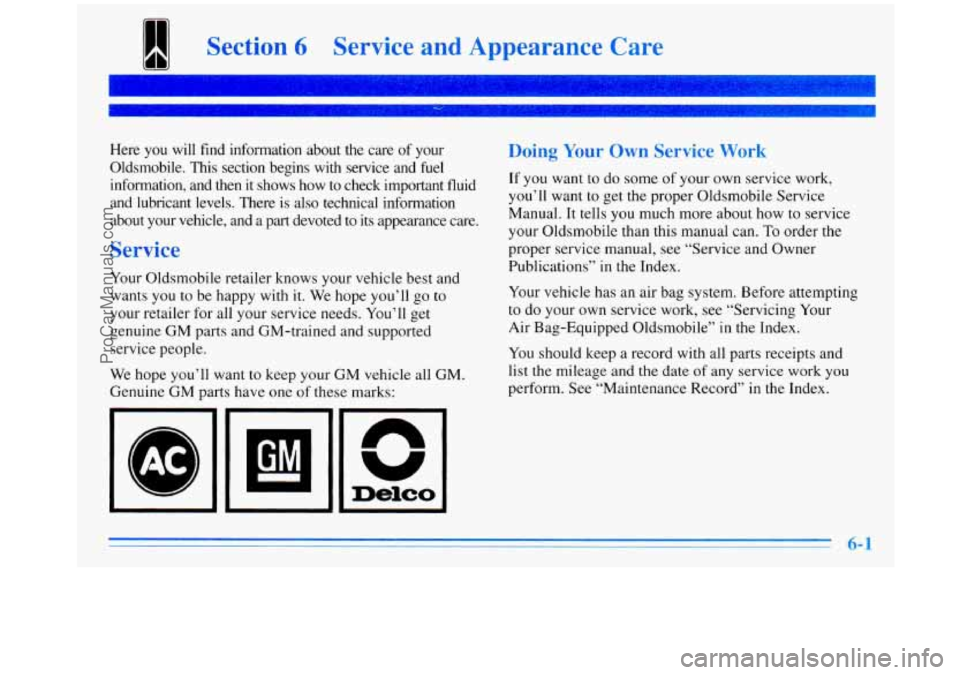
Section 6 Service and Appearance Care
Here you will find information about the care of your
Oldsmobile. This section begins with service and fuel information, and then
it shows how to check important fluid
and lubricant levels. There is also technical information
about your vehicle, and a part devoted to its appearance care.
Service
Your Oldsmobile retailer knows your vehicle best and
wants you to be happy with
it. We hope you’ll go to
your retailer for
all your service needs. You’ll get
genuine GM parts and GM-trained and supported
service people.
We hope you’ll want to keep your GM vehicle all GM.
Genuine GM parts have one of these marks:
Delco
Doing Your Own Service Work
If you want to do some of your own service work,
you’ll want to get
the proper Oldsmobile Service
Manual. It tells you much more about how
to service
your Oldsmobile than this manual can. To order the
proper service manual, see “Service and Owner
Publications” in
the Index.
Your vehicle has an air bag system. Before attempting
to do your own service work,
see “Servicing Your
Air Bag-Equipped Oldsmobile” in
the Index.
You should keep a record with all parts receipts and
list the mileage and the date
of any service work you
perform. See “Maintenance Record” in the Index.
6-1
ProCarManuals.com
Page 248 of 372
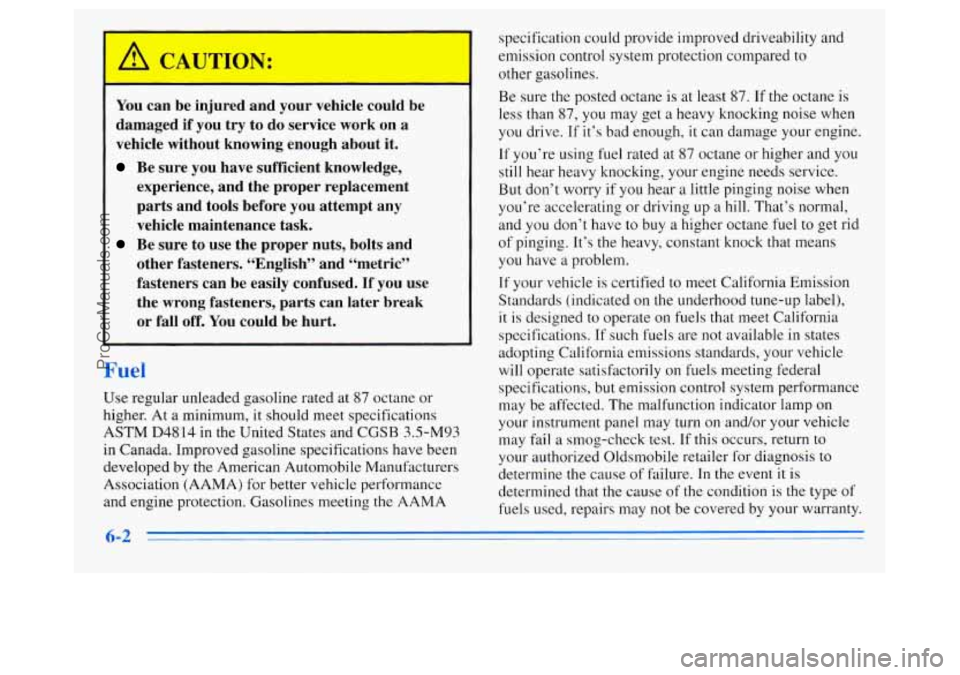
You can be injured and your vehicle could be
damaged if you try to do service work on a vehicle without knowing enough about it.
Be sure you have sufficient knowledge, experience, and the- proper replacement
parts and tools before you attempt any
vehicle maintenance task.
Be sure to use the proper nuts, bolts and
other fasteners. “English” and “metric”
fasteners can be easily confused.
If you use
the wrong fasteners, parts can later break
or fall
off. You could be hurt.
Fuel
Use regular unleaded gasoline rated at 87 octane or
higher. At a minimum, it should meet specifications
ASTM D4814 in the United States and CGSB 3.S-M93
in Canada. Improved gasoline specifications have been
developed by the American Automobile Manufacturers
Association (AAMA) for better vehicle performance
and engine protection. Gasolines meeting
the AAMA specification could provide improved driveability
and
emission control system protection compared to other gasolines.
Be sure
the posted octane is at least 87. If the octane is
less than
87, you may get a heavy knocking noise when
you drive.
If it’s bad enough, it can damage your engine.
If you’re using fuel rated at 87 octane or higher and you
still hear heavy knocking, your engine needs service.
But don’t worry
if you hear a little pinging noise when
you’re accelerating or driving up
a hill. That’s normal,
and you don’t have to buy
a higher octane fuel to get rid
of pinging. It’s the heavy, constant knock that means
you have
a problem.
If your vehicle is certified to meet California Emission
Standards (indicated on the underhood tune-up label),
it is designed to operate on fuels that meet California
specifications. If such fuels are not available
in states
adopting California emissions standards, your vehicle
will operate satisfactorily
on fuels meeting federal
specifications, but emission control system performance
may be affected. The malfunction indicator lamp on
your instrument panel may turn
on and/or your vehicle
may fail a smog-check test. If this occurs, return to
your authorized Oldsmobile retailer for diagnosis to
determine the cause of failure. In the event
it is
determined that the cause of the condition
is the type of
fuels used, repairs may not be covered by your warranty.
6-2
ProCarManuals.com
Page 260 of 372
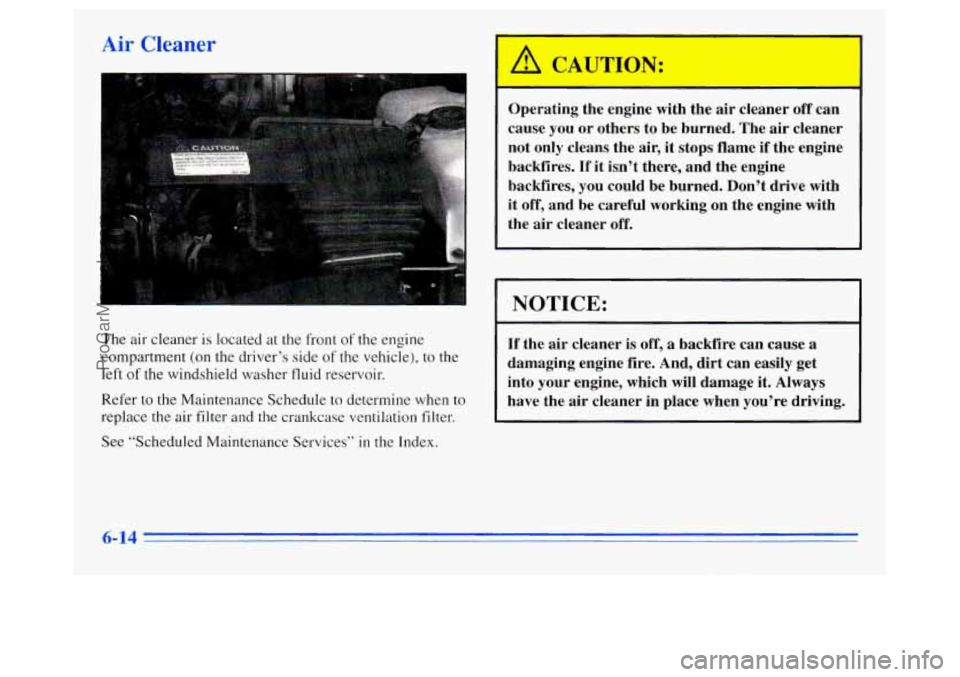
L *r C1 mer
The air cleaner is located at the front of the engine
compartment (on the driver’s side
of the vehicle), to the
left of the windshield washer fluid reservoir.
Refer to the Maintenance Schedule
to determine when to
replace the air filter and the crankcase ventilation filter.
See “Scheduled Maintenance Services” in the Index.
A CAUTION:
cause you or others to be burned. The air cleaner
not only cleans the air, it stops flame if the engine
backfires. If it isn’t there, and the engine
backfires, you could be burned.
Don’t drive with
it off, and be careful working on the engine with
the air cleaner off.
NOTICE:
If the air cleaner is off, a backfire can cause a
damaging engine fire. And, dirt can easily get
into your engine, which will damage it.
Always
have the air cleaner in place when you’re driving.
6-14
ProCarManuals.com
Page 261 of 372

Checking or Replacing the Air Cleaner
1. Loosen the four wing nuts.
2. Pull the top of the air cleaner toward the fro t of the
vehicle and remove the air cleaner filter.
P
3. Be sure to install the air cleaner filter, replace the
cover and tighten the wing nuts securely.
Automatic Transaxle Fluid
When to Check and Change
A good time to check your automatic transaxle fluid
level is when the engine oil is changed.
Change both the fluid and filter every
50,000 miles
(83 000 krn) if the vehicle is mainly dnven under one or
more of these conditions:
In heavy city traffic where the outside temperature
regularly reaches
90 OF (3 2 O C) or higher.
0 In hilly or mountainous terrain.
0 When doing frequent trailer towing.
Uses such as found in taxi, police or delivery service.
If you do not use your vehicle under any
of these
conditions, the fluid and filter do not require changing.
See “Scheduled Maintenance Services” in the Index.
6-15
ProCarManuals.com
Page 264 of 372

DW to 2 dl uid
Refer to the Maintenance Schedule to determine what
kind
of transaxle fluid to use. See “Recommended
Fluids and Lubricants” in the Index.
If the fluid level is low, add only enough
of the proper
fluid to bring the level into the cross-hatched area on
the dipstick.
1. Pull out the dipstick.
2. Using a long-neck funnel, add enough fluid at the
dipstick hole to bring it
to the proper level. It doesn’t
take much fluid, generally less than a pint
(0.5 L).
Don ’t overfill. We recommend you use only fluid
labeled DEXRON@-111, because fluid with that
label is made especially for your automatic transaxle.
Damage caused
by fluid other than DEXRON-111 is
not covered by your new vehicle warranty.
0 After adding fluid, recheck the fluid level as
described under “How
to Check.”
When the correct fluid level is obtained, push the
dipstick back in all the way. The
cooling system in your vehicle is filled with new
DEX-COOL
TM (orange-colored, silicate-free) engine
coolant. This coolant is designed to remain in your
vehicle for
5 years or 100,000 miles (166 000 km),
whichever occurs first.
The following explains your cooling system and how to
add coolant when it is low.
If you have a problem with
engine overheating, see “Engine Overheating” in
the Index.
A 50/50 mixture of water and the proper coolant for
your Oldsmobile will:
0 Give freezing protection down to -34°F (-37°C).
0 Give boiling protection up to 265°F (129°C).
Protect against rust and corrosion.
0 Help keep the proper engine temperature.
0 Let the warning lights and gages work as they should.
ProCarManuals.com
Page 269 of 372

When to Check Power Steering Fluid
It is not necessary to regularly check power steering
fluid unless you suspect there is a leak in the system or
you hear an unusual noise.
A fluid loss in this system
could indicate a problem. Have the system inspected
and repaired.
How To Check Power Steering Fluid
When the engine compartment is cool, unscrew the cap
and wipe the dipstick with
a clean rag. Replace the cap
and completely tighten
it. Then remove the cap again
and look at the fluid level on the dipstick.
When the engine compartment is hot, the level should be
at the
H mark. When it’s cold, the level should be at the
C mark. If the fluid is at the ADD mark, you should
add fluid.
What to Use
Refer to the Maintenance Schedule to determine what
kind of fluid
to use. See “Recommended Fluids and
Lubricants” in the Index. Always use the proper fluid.
Failure to use the proper fluid can cause leaks and
damage hoses and seals.
Windshield Washer Fluid
What to Use
When you need windshield washer fluid, be sure to read
the manufacturer’s instructions before use. If you will be
operating your vehicle in an area where the temperature
may fall below freezing, use a fluid that has sufficient
protection against freezing.
6-23
ProCarManuals.com